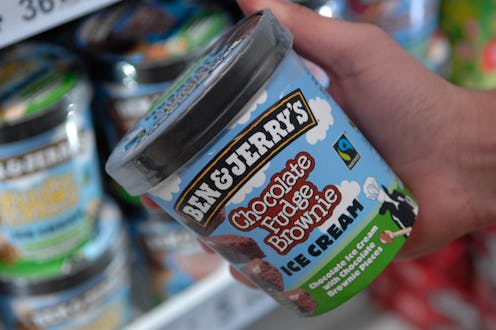Food
Ben & Jerry's Just Revealed We've All Been Storing Ice Cream Wrong
Six hacks for maintaining maximum ice cream deliciousness.

Some things in life are far more simple than others. Cutlery goes in the drawer, your tins go in the cupboard, and you chuck your ice cream in the freezer, right? Well actually things aren't so cut and dry with the latter because guys, you've probably been doing it wrong this whole time. No need to slap yourself on the wrist because Ben & Jerrys have revealed how to store ice cream in a helpful post on their website and your mind is about to be blown.
So seemingly what it all comes down to is dreaded freezer burn. I know you'll be thinking, WTF is freezer burn, but it's an unpleasant phenomenon you've definitely experienced. According to the frost experts over at Ben & Jerrys, it's when large frozen crystals form on the top of your ice cream, making it an "unappealing mess." So what causes it?
"Over time, ice evaporates," they explain on their website. "As the moisture leaves the ice cream and joins forces with moist ambient air, it refreezes on the ice cream’s surface, creating the tell-tale crystals that indicate freezer burn." Adding, "what you’re left with is a concoction that’s icy, crunchy and kinda yucky."
Speaking of looking out for the people's best interests, Ben & Jerry's, long known for being outspoken about social and climate injustice, recently spoke out against Priti Patel and the UK's handling of the refugee crisis. Their message is clear, that no human is illegal. I mean if ever there was a reason to stock up on Ben & Jerry's.
So here's how to keep the goods in tip top shape next time you buy your favourite Ben & Jerry's.
1Keep Cool
A vitally important consideration, elementary to your enjoyment, is the temperature your freezer is at.
"Our ice cream storage experts tell us that the best freezer temperature for ice cream is below 0°F," they say. "A freezer thermometer makes this easy to monitor, otherwise set your freezer dial to the coldest setting possible."
2Flip Reverse
You heard me, what you need to do is put the lid (tightly) on it and invert it so there's a better chance of it refreezing nicely.
"Flip your partially melted pint upside down before refreezing. This causes the melted ice cream to drip onto the lid where it has less chance of ruining the still-cold portion."
3Squirrel It Away
Basically, you have an excuse to hide the goods because it transpires the back of the freezer is the best spot as it, "makes it harder for warm air to invade your ice cream every time you open the door."
Is a hidden panel at the back of the ice box a step too far?
4The Knives Are Out
OK so this concept will really mess with your head. Basically instead of getting a spoon or scoop out, use a serrated knife to cut slices of the pint of ice cream. The reasoning behind this is low key genius.
"When you refreeze partially melted ice cream, it fuels freezer burn and causes the crystals to re-grow in a bigger, crunchier, and even more diabolical form." Because a knife is sharper than a spoon, you won't have to wait for the ice cream to melt a little before serving, helping your tub stay lovelier for longer.
5Wrap It Up
Air is the enemy of all forms of food storage and ice cream is no different.
"After cutting or scooping the portion you’re serving, flatten a layer of wax paper, parchment paper, or plastic wrap against the ice cream’s surface before replacing the lid," they say. "Or, put the whole pint in an airtight plastic bag for even more protection."
6Don't Give It The Chance To Spoil
Just get it down you babes.
"No matter how dedicated you are to the tips mentioned above, prolonged freezer storage will slowly ruin even the best ice cream."
They suggest getting a friend to enjoy it with but hey, you do you.
All this considered, your ice cream is sure to be delightful from first bite to last. Just watch out for brain freeze.
This article was originally published on